Lithuania's property market stabilizing
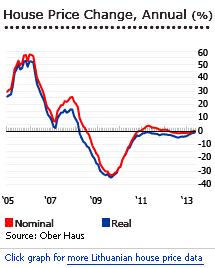 Lithuania’s property market is now improving, amidst healthy economic growth. House prices continue to fall, but at a slower pace. Demand is slightly up. Construction activity is rising again.
Lithuania’s property market is now improving, amidst healthy economic growth. House prices continue to fall, but at a slower pace. Demand is slightly up. Construction activity is rising again.
The apartment price index for Lithuania’s five major cities (Vilnius, Kaunas, Klaipėda, Šiauliai and Panevėžys) dropped by 0.9% (-2.3% inflation-adjusted) during the year to end-June 2013, according to Ober Haus Real Estate Advisors. This is an improvement from a year-on-year nominal price declines of 1.6%, 1.7% and 1.7% in the previous three quarters.
On a quarterly basis, apartment prices rose by 0.1% (-0.2% inflation-adjusted) during Q2 2013.
In Vilnius, the capital, apartment prices rose 0.2% to €1,198 per square metre (sq. m.) in Q2 2013 from a year earlier. However, adjusted for inflation apartment prices actually declined 1%.
A quick snapshot of house prices elsewhere in Lithuania in June 2013:
- In Kaunas, the average price of newly-constructed flats was €1,050 per sq. m., versus €700 per sq. m. for existing flats
- In Klaipėda, the average price of new flats was €1,100 per sq. m, versus €800 per sq. m for existing flats.
- In Šiauliai, the average price of newly-built flats was €750 per sq. m. , versus €500 per sq. m. for existing flats
- In Panevėžys, newly-built flats had an average price of €800 per sq. m., versus was €450 per sq. m. for existing flats.
Residential property prices in the capital started to decline in 2008, mainly due to the adverse impact of the global credit crunch. The housing market has not yet fully recovered since then.
- In 2008, house prices fell by 13.7% (-20.5% inflation-adjusted)
- In 2009, house prices plunged by 30.3% (-31.2% inflation-adjusted)
- In 2010, house prices increased by a meagre 0.1% (-3.6% inflation-adjusted)
- In 2011, house prices rose slightly by 0.8% (-2.6% inflation-adjusted)
- In 2012, house prices dropped 1.4% (-4.1% inflation-adjusted)
In the first quarter of 2013, the total number of dwellings completed increased by 15.2% to 1,578 units from the same period last year, according to Statistics Lithuania. The total number of dwellings authorized rose by 6.5% to 2,035 units over the same period.
Transactions of detached houses in Lithuania rose by 3% in the second quarter of 2013 from the same quarter last year, according to the Centre of Registers, to 775 per month, up from a monthly average of 750 in Q2 2012. Likewise, the number of apartment transactions also increased to an average of 2,400 per month in Q2 2013, up from 1,830 per month in Q2 2012.
Outstanding housing loans in the country dropped by 0.8% to LTL19.94 billion (€5.78 billion) in June 2013 from the same period last year, based on latest figures released by the Association of Lithuanian Banks.
The Lithuanian economy expanded by 3.7% from a year earlier in the second quarter of 2013, according to Statistics Lithuania. The economy is expected to grow by 3.1% this year, after annual GDP growth of 3.6% in 2012, 5.9% in 2011 and 1.5% in 2010.
That crazy house price boom
The average price of old apartments in Central Vilnius rose 275% between 2002 and 2006:
- 2003: prices increased 28%
- 2004: prices increased 29%
- 2005: prices increased 45%
- 2006: prices increased 56%
The average price of newly constructed one-bedroom apartments in central Vilnius rose 162% from 2002 to 2006.
Booms in other cities, a nation mortgaged
Major price increases were also seen in other major cities. In Klaipeda, Lithuania’s third largest city and only seaport, the average price of one-room apartments rose 282% from LTL2,200 (€637) per sq. m. in 2003, to LTL9,000 (€2,607) per sq. m. at end-2007.
Mortgage debt rose from a mere 0.4% of GDP in 2000, to 19% of GDP in 2008, with about 80% of all purchases made with the aid of mortgages, and typically 95% of property value granted in loans.
Total outstanding housing loans in Lithuania increased by 3.1% to LTL4.47 billion (€1.29 billion), according to the Bank of Lithuania - still 38.9% lower than the peak levels seen in September 2007, when total housing loans were about LTL7.32 billion (€2.12 billion).
Interest rates and currency risk
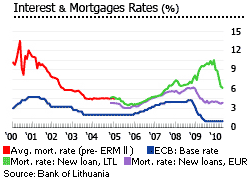
Recently, interest rates on Lithuania litas (LTL) housing loans have increasingly reflected worries about currency risk.
From 2005 to mid-2007, there was not much difference between interest rates on new housing loans whether denominated in litas or in euro. The divergence widened in January 2009 and from mid-2009 they seemed to follow different paths. Interest rates on litas-denominated new housing loans surged to around 10% from April to October 2009, before falling to 6.2% in March 2010, while interest rates on euro-denominated housing loans simply followed the key ECB rate downward.
The litas-dollar peg lasted from 1994 to January 2002 (US$ 1 = LTL4), and from 1999 to 2001, average housing loan rates fluctuated from 8% to 14%. In February 2002 the litas was re-pegged to the euro at €1 = LTL3.4528. Housing loan interest rates declined to less than 6% in 2002, and to less than 4% between July 2005 and May 2006.
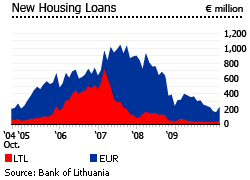
The interest rate hikes of 2006-2009 had disastrous effects, as almost all new loans approved between 2004 and Q3 2006 had an initial rate fixation (IRF) of less than one year.
As well as causing distress to borrowers, the interest rate hikes caused the market to shift to Euro. In 2006, only 44% of new loans were denominated in Euro, but from 2009 to Q1 2010, the ratio of Euro-denominated loans rose to around 80% to 90% of new loans. If the litas does disconnect from the euro, the consequences for borrowers would be disastrous.
In September 2012, the average interest rate paid by households for a housing loan denominated in Lithuania litas (LTL) dropped to 3.29%, from 3.88% in the same period last year, according to the Bank of Lithuania.
Construction activity improving
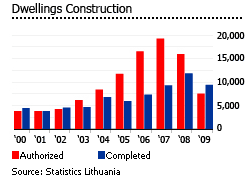
During the 1980s, when the country was still under socialism, more than 20,000 dwelling units were constructed annually.
Completions dropped to less than 5,000 annually between 1998 and 2003, leaving a huge, pent-up demand.
As the economy gathered steam, housing construction accelerated:
- In 2004-2006 dwellings completions rose to an average of 6,700 yearly
- In 2007, there were 9,286 completed dwellings
- In 2008 dwelling completions rose to 11,286, the highest since 1992
- In 2009, completions dropped to 9,400 units due to the economic crisis.
In 2009, completions dropped to 9,400 units, due to the economic crisis.
The number of unfinished dwelling units was alarming. From 2005 to 2008, 15,000 dwellings were authorized annually - around three times the number of completions. While some authorized dwellings may never have gone beyond the drawing board, the amount of ongoing construction in Lithuania, especially Vilnius, suggests that many are still being built – but are not yet finished.
The drop in construction activity was also reflected in the drop in the number of dwellings authorized; from 19,229 units in 2007 to 15,928 in 2008 and 7,553 in 2009.
Now, the construction sector is improving again. The number of dwellings authorized was up by 16.7% in Q3 2012 on the same period last year (but fell by 4.2% in Q3 2012 from the previous quarter) according to Statistics Lithuania. And the number of dwellings completed was 29.8% higher in Q3 2012 than a year earlier (though it fell slightly by 1.4% q-o-q).
Rental yields in Vilnius still very low
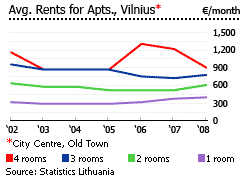
While prices tripled in Vilnius from 2002 to 2006, rents stayed mostly flat. From 2002 to 2007, the average rent for a one bedroom apartment rose by a mere 18% while the average apartment sale price soared by 197% (from € 1,217 per sq. m. to €3,623).
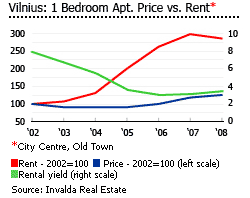
Despite the crash in prices, rental yields are still low. In August 2009, luxury apartments in Vilnius yielded 4.44% on average, according to the Global Property Guide. Smaller units (30 sq. m.) achieved higher yields at around 6.3%, while slightly bigger units (90 – 200 sq. m.) had yields ranging from 3.8% to 4%. In contrast in 2002, Vilnius yields typically ranged from 8% to 10%.
Modest economic growth
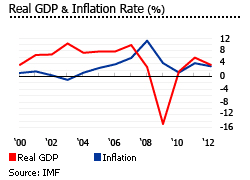
After average growth of 8.1% from 2001 to 2007 the economy began to slow in 2008, due to contagion from the global financial meltdown. In 2009, economy shrank by almost 15%, the worst recession in the EU, largely due to the bursting of the property bubble, higher tax rates, the end of cheap money and a huge contraction in exports.
In 2010, the economy finally emerged from recession with GDP growth of 1.5%.
Then in 2011 the Lithuanian economy began to expand strongly, with real GDP growth of 5.9%, the second fastest pace in the EU. In 2012, the economy grew by a healthy 3.6%. In the second quarter of 2013, the Lithuanian economy expanded by 3.7% from a year earlier, after an annual growth of 3.5% in the previous quarter, according to Statistics Lithuania.
Economic growth is expected to slow this year, to 3.1%, based on forecast released by the EU. On the other hand, the country’s central bank is more pessimistic, forecasting GDP growth of 2.8% this year.
In March 2013, nationwide unemployment was 12.4%, according to the Lithuanian Labour Exchange (LDB). Vilnius had the lowest jobless rate at 9%, followed by Klaipėda (9.3%) and Šiauliai (9.4%).
Lower income tax
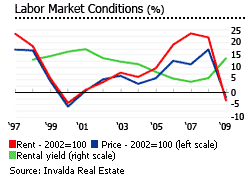
The Lithuanian government compounded its difficulties by actually lowering its income tax rate in the middle of the global crisis. Lithuania’s tax rate is now lower than Estonia’s 21% and Latvia’s 26%.
In the mid-1990s, like its Baltic neighbors, Lithuania implemented a flat-tax on personal income. The idea was that a simple and uniform tax is conducive to business and economic growth.
After achieving double-digit GDP growth rates, the flat tax was reduced from 33% to 27% in 2007, and 24% in 2008. Despite the ongoing crisis, in 2009 Lithuania pushed through with a final planned reduction of personal income tax to 15%.
The value-added tax (VAT) was raised to 21% (from 18%; the sale and lease of immovable properties remains VAT-exempt). Corporate taxes were reduced to 15%, down from the standard rate of 20%.
Tax-deductibility on housing loan interest payments was abolished in January 2009, adding to borrowers’ problems. As of early-2010, the mortgage market remained frozen.
Lithuania’s neighbours reacted differently to their budget crises. Estonia abandoned its earlier plan of lowering its flat tax to 18% after 2012 (from 21%) – having introduced a 26% flat tax in 1994, and reduced it gradually.
Similarly in January, Latvia raised its flat tax to 26%. Latvia had lowered its personal income tax rate to 23% in 2009, from 25%.
Budget deficit now at 2.8% of GDP
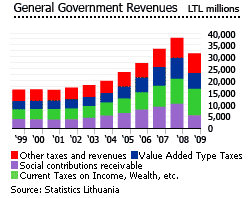
During the global crisis, government income and wealth taxes fell almost by half from LTL 10.4 billion (€3.016 billion) in 2008, to LTL 5.5 billion (€1.6 billion) in 2009. Yet despite the VAT rate increase, VAT-type revenues fell from LTL8.7 billion (€2.5 billion) in 2008, to LTL6.6 billion (€1.9 billion) in 2009.
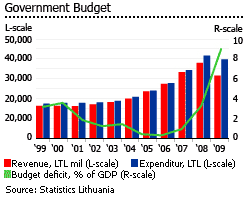
Total government revenues plunged 17%, while expenditure declined by a mere 4.6%. The revenues/expenditure mismatch pushed the budget deficit to 9.4% of GDP in 2009, from 3.3% in 2008, and 1% or less from 2005 to 2007.
During the first three quarters of 2012, Lithuania’s budget deficit improved dramatically to about 2.8% of GDP, down from 3.3% of GDP in a year earlier, according to the Ministry of Finance.
Moderate inflation
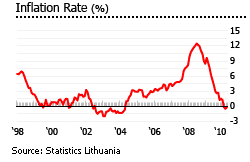
Similar to other countries with currencies pegged to the euro, Lithuania has surrendered its ability to raise interest rates to control inflation. To be able to maintain the peg, interest rate movements set by the European Central Bank are mirrored in Lithuania.
From 1999 to 2003, consumer prices in Lithuania barely increased, with average annual inflation of only 0.38%. Inflation then accelerated, reaching 11.1% in 2007, the highest level in a decade.
In November 2007, the government passed the Fiscal Discipline Law which mandating that starting 2008, the annual fiscal deficit cannot exceed 0.5% of GDP. However, the deficit still reached 3.3% of GDP in 2008.
The sharp economic contraction during the global crisis pushed down inflation to 4.2% in 2009 and to 1.2% in 2010. The overall inflation rate increased to 4.1% in 2012 but fell slightly to 3.2% in 2012.
The country’s annual headline inflation fell to 1.2% in June 2013, the lowest level in three years.